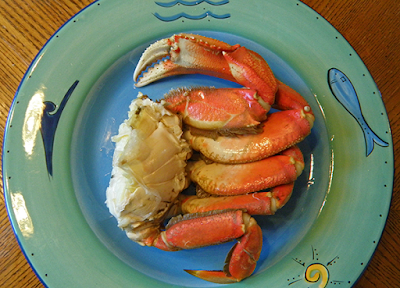 |
| One Half (1 lb. plus) Crab Per Person |
Recipe for New Year's
The very last day of 2011, a time to reflect on the past
year and contemplate the New Year ahead. On the central CA coast, New Year’s is
also a traditional time to enjoy crab. This year is particularly good, as the
Dungeness crab population is booming and crab season opened almost a month
early. The Dungeness crab fishery is sustainable,
with very little bycatch. Crab pots are designed to catch only legal-size
individuals, and have little impact upon the surrounding environment. So crab is an environmentally friendly as well as delicious choice.
 |
| Reheating Crab: Damp Towel & Microwave |
Selecting Crab
Crab meat deteriorates and becomes fishy-tasting rapidly, so
you want to find the freshest source and avoid others. Find a market where crab
inventory turns over quickly. Some clues: many customers are buying it, or the
number of crabs available decreases dramatically throughout the day.
 |
| Assembling Tools to Crack Crab |
Buy crab early in the day. It’s a good idea to ask when the
crab was delivered, if you’re not sure that the market gets daily deliveries.
I like getting crabs professionally cleaned where I buy them.
If you need the carapace for the way it looks on the plate, it can usually be
saved as well. Crab innards are very perishable and can affect the taste of the
part you will eat, especially if you reheat it.
 |
| Cracking Crab 1: Remove Meat from Body |
If crabs weight 1 lb. or more, allow a half-crab per person. If you think some guests might eat more than that, get some extra. You can always use leftover crab for crabcakes (recipe soon!) For sweetest taste, be sure to remove it from the shell as soon as you can.
Prepare and eat crab as near to the time that you buy it as
possible. It makes a great lunch as well as dinner.
Cleaning the crab before reheating (if not cleaned in the
market) will result in better taste.
To reheat, I prefer the microwave, because less cooking is
needed. Always use damp heat, and check frequently to avoid overcooking. Wrap
in damp towel (paper okay) and microwave about a minute, more if you like it
hotter, but no more than 2 minutes. Others recommend traditional steaming: put into traditional
steamer and steam for 5 – 10 minutes, till hot. Don’t overcook!
Serve with a regular nutcracker and small fork. Kitchen
shears can also be useful in removing meat from shells.
Cracking Crab for use in Recipes
Be forewarned that this process can be messy. Wear an apron or old shirt. Cover surface with butcher paper. Assemble two bowls (one for crabmeat, one for shells), kitchen shears, small fork, and nutcracker.
Remove legs from body. Shell is thin on body, so you can tear it with your fingers (or use shears) and remove meat with small fork or your fingers.
Use nutcracker to crack claws, remove meat with fingers or small fork.
Legs can sometimes be cracked with nutcracker, but most often this will collapse shell into meat. I prefer to use the kitchen shears, and remove the meat with my fingers or the fork.
 |
| Cracking Crab 3: Removing Leg Meat |
Be forewarned that this process can be messy. Wear an apron or old shirt. Cover surface with butcher paper. Assemble two bowls (one for crabmeat, one for shells), kitchen shears, small fork, and nutcracker.
Remove legs from body. Shell is thin on body, so you can tear it with your fingers (or use shears) and remove meat with small fork or your fingers.
Use nutcracker to crack claws, remove meat with fingers or small fork.
Legs can sometimes be cracked with nutcracker, but most often this will collapse shell into meat. I prefer to use the kitchen shears, and remove the meat with my fingers or the fork.
Happy New Year All! Let’s honor the passing of 2011 by remembering what we’ve learned and done, and welcome 2012, a blank slate to begin filling with happy memories.

No comments:
Post a Comment